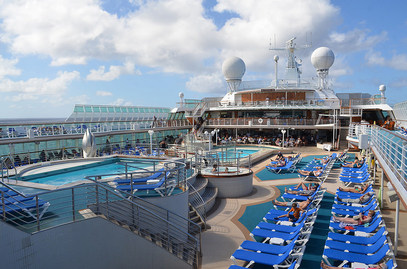
Of all the vacation trip choices out there, cruising appears to have the greatest need to defend itself. Non-cruisers often are misinformed about shipboard life, landlubbers are anxious about the possibility of seasickness, and those who dislike closed spaces will avoid cruise ship cabins — just to name a few. But we think that these “obstacles” shouldn’t dissuade consumers from booking a vacation at sea. Here are five cruise myths, debunked:
1. Mass market ships are just party boats.
While it’s true that many cruisers aboard lines such as Carnival Cruise Lines, Norwegian Cruise Line, and Royal Caribbean International are looking for a festive atmosphere, others who want peace and quiet can easily find it on those very same lines. Today’s cruise ships are large enough to provide tranquil spaces, in the form of adults-only pool and lounge areas, out-of-the-way bars, and intimate dining venues. Passengers can read a book, sip a drink, or enjoy dinner well away from the mayhem in all of these spaces. If you are looking for extra relaxation, take a look at a ship’s deck plans and review public area descriptions to see if the facilities fit the bill.
2. Cabins are claustrophobic.
Cruisers have a wide range of cabin choices these days. For those who don’t like closed spaces, a balcony cabin is the answer. Of course, not all vacation budgets can accommodate such staterooms — but options like a partial-view porthole cabin provide a less-cramped ambience at very small increases in cost. (A partial-view cabin refers to one that has a window that’s partly obstructed by something outside, such as a lifeboat.) Disney Cruise Line also boasts “magical portholes” in many of its inside cabins, featuring screens displaying outside views to give the illusion of a window.
3. Cruises are more expensive than land trips.
Cruise rates change very frequently, based on occupancy levels day to day and week to week. The industry currently is offering some of its lowest rates in years on summer and fall Caribbean cruises, many as low as $50 or $60 per person, per day. Considering that all meals and entertainment are included in the fare, consumers are likely hard-pressed to find a better value.
4. I’ll get seasick.
High winds and rolling seas can make a cruise ship tilt from side to side as it steams toward its next port call. But anti-seasickness medications are always available — for free — from a ship’s medical office. Passengers have also had luck with anti-seasickness wristbands, found in any pharmacy and reusable.
5. I’ll be bored on a ship.
This statement may have been true 20 years ago, but certainly not today. Outdoor activities on many ships include ropes courses, climbing walls, basketball courts, mini-golf courses, dive shows, and more. Inside, a vast array of music performances, movies, games, and sports bars provide hours of entertainment. That’s not to mention shore excursions where cruisers can stretch their legs dockside (a weeklong cruise will typically have at least three ports of call).
Shermanstravel.com
July 10, 2014 by Donna Tunney
1. Mass market ships are just party boats.
While it’s true that many cruisers aboard lines such as Carnival Cruise Lines, Norwegian Cruise Line, and Royal Caribbean International are looking for a festive atmosphere, others who want peace and quiet can easily find it on those very same lines. Today’s cruise ships are large enough to provide tranquil spaces, in the form of adults-only pool and lounge areas, out-of-the-way bars, and intimate dining venues. Passengers can read a book, sip a drink, or enjoy dinner well away from the mayhem in all of these spaces. If you are looking for extra relaxation, take a look at a ship’s deck plans and review public area descriptions to see if the facilities fit the bill.
2. Cabins are claustrophobic.
Cruisers have a wide range of cabin choices these days. For those who don’t like closed spaces, a balcony cabin is the answer. Of course, not all vacation budgets can accommodate such staterooms — but options like a partial-view porthole cabin provide a less-cramped ambience at very small increases in cost. (A partial-view cabin refers to one that has a window that’s partly obstructed by something outside, such as a lifeboat.) Disney Cruise Line also boasts “magical portholes” in many of its inside cabins, featuring screens displaying outside views to give the illusion of a window.
3. Cruises are more expensive than land trips.
Cruise rates change very frequently, based on occupancy levels day to day and week to week. The industry currently is offering some of its lowest rates in years on summer and fall Caribbean cruises, many as low as $50 or $60 per person, per day. Considering that all meals and entertainment are included in the fare, consumers are likely hard-pressed to find a better value.
4. I’ll get seasick.
High winds and rolling seas can make a cruise ship tilt from side to side as it steams toward its next port call. But anti-seasickness medications are always available — for free — from a ship’s medical office. Passengers have also had luck with anti-seasickness wristbands, found in any pharmacy and reusable.
5. I’ll be bored on a ship.
This statement may have been true 20 years ago, but certainly not today. Outdoor activities on many ships include ropes courses, climbing walls, basketball courts, mini-golf courses, dive shows, and more. Inside, a vast array of music performances, movies, games, and sports bars provide hours of entertainment. That’s not to mention shore excursions where cruisers can stretch their legs dockside (a weeklong cruise will typically have at least three ports of call).
Shermanstravel.com
July 10, 2014 by Donna Tunney